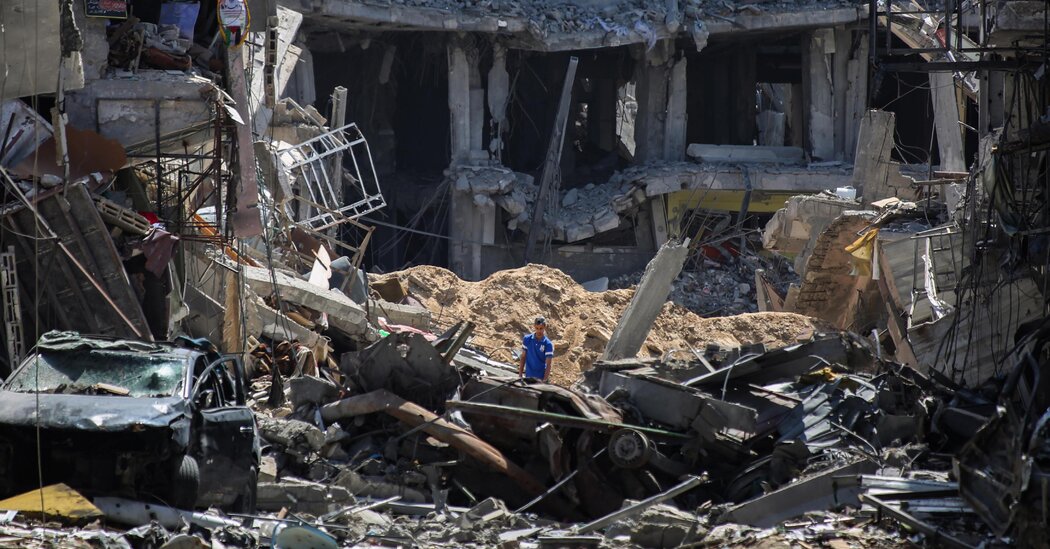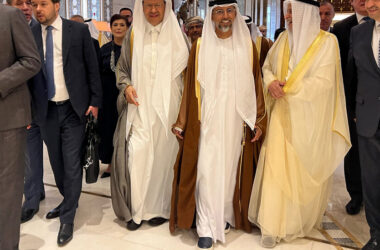On a December morning in central London, more than two dozen people drawn from influential institutions across the Middle East, Europe and the United States gathered in a conference room to pursue an aspiration that, at that moment, verged on preposterous. They were there to plan for the reconstruction and long-term economic development of Gaza.
Gaza was under relentless bombardment by Israeli military forces in response to terrorist attacks launched by Hamas in October. Communities throughout the territory were being reduced to rubble, and tens of thousands of people had been killed. Families confronted the immediacy of hunger, fear and grief.
Yet at the meeting in London, members of the international establishment discussed how to eventually transform Gaza from a place defined by isolation and poverty into a Mediterranean commercial hub centered on trade, tourism and innovation, yielding a middle class.
The group included senior officials from American and European economic development agencies, executives from Middle Eastern finance and construction companies and two partners from the international consulting firm McKinsey & Company. Officially, they were attending only as individuals, not as representatives of their institutions.
The plan they produced is far removed from the dire reality confronting Gaza today. Turning it into reality would require the end of a war that has left the territory devastated, to say nothing of tens of billions of dollars in investment. It would also demand resolution to the monumental and entirely uncertain political question of who eventually controls Gaza, and then the cooperation of that authority. All of that makes the plan well short of a blueprint for action.
Yet participants maintain that the mere exercise of mapping out a more prosperous future holds value because it can prepare the way for projects once conditions are suitable — a notion that has propelled such planning in conflict zones like Kuwait after it was invaded by Iraq and Ukraine.
“We are proposing to connect Gaza to the world over the long term,” said Chris Choa, founder and director of Outcomist, a London firm that designs large-scale urban development projects, and one of the initial conveners of the group, known as Palestine Emerging.
Among those involved are Hashim Shawa, chairman of the Bank of Palestine, a commercial bank; Samer Khoury, chief executive of Consolidated Contractors International, a construction company engaged in major projects across the Middle East; and Mohammed Abukhaizaran, a board member of the Arab Hospitals Group, a medical provider in the West Bank. All would potentially have a stake in the eventual work of rebuilding.
“As soon as the war started, my team and I started developing a plan to build a facility in Gaza as soon as the war ends,” Mr. Abukhaizaran said in an interview.
The group is clear that the most pressing work is the delivery of food, water, health care and emergency shelter to the residents of Gaza, who are now contending with catastrophe. But the primary focus of their plan is on the rebuilding that would unfold over the following decades.
“The Gaza war needs to end immediately, and there will be an incredible and immediate humanitarian effort,” said Mr. Abukhaizaran. “But we also need to think long term about building a better future for Palestinians in Gaza and the West Bank.”
The initiative, one of several under discussion, has gained the interest and advice of major international funding organizations including the World Bank, said a senior agency official who spoke on the condition of anonymity because they were not authorized to talk publicly. The bank views the plan as a useful contribution toward a strategy that could generate jobs in Gaza by integrating the territory into the global economy.
Representatives for United States government agencies have attended Palestine Emerging workshops and offered counsel on the details of the plan, a senior American official said, also speaking on condition that they not be named. American engagement with the initiative has been driven by the assumption that greater economic opportunity in Gaza is necessary to undercut popular support for Hamas, the official added.
The plan centers on a series of major projects, including a deepwater port, a desalination plant to provide drinking water, an online health care service and a transportation corridor connecting Gaza with the West Bank. A fund for reconstruction and development would oversee future undertakings.
The most forward-looking components, such as reducing customs barriers to trade and introducing a new currency in place of the Israeli shekel, assume the eventual establishment of Palestinian autonomy, a step that Israel’s prime minister, Benjamin Netanyahu, has vowed to resist. He has also brushed aside the prospect that the future governance of Gaza could include a role for the Palestinian Authority, the most obvious potential partner for the reconstruction initiative.
The enormous price tag of any rebuilding is another impediment. The toll of the damage to Gaza’s crucial infrastructure has reached $18.5 billion, according to a recent estimate by the World Bank and the United Nations. Half the population is on the verge of famine, and more than a million people lack homes.
Who might deliver such funding is among the largest variables. A previous development plan for the Palestinian territories advanced by the Trump administration in 2019 envisioned substantial investment from Persian Gulf countries like the United Arab Emirates and Bahrain. The new initiative has yet to engage with the Gulf countries, Mr. Choa said.
The imperative for development in Gaza predates the current war. The unemployment rate in the territory was more than 45 percent in 2022, according to the World Bank. More than half the population was living in poverty, according to the International Monetary Fund.
While visions of modern transportation systems may now seem tangential to Gaza’s essential needs, the plan is governed by the assumption that even temporary structures like emergency housing and health care facilities must be thoughtfully placed to avoid squandering future possibilities.
“Temporary tends to become permanent very quickly,” Mr. Choa said. “Someone says, ‘We’re going to put this big refugee camp right here,’ but that could be exactly where you want to put a wastewater treatment plant or a transit line in the future. You then create an obstacle.”
Mr. Choa, 64, has spent much of his international architectural career wrestling with such details. After the attacks on the World Trade Center on Sept. 11, 2001, he took part in a commission tasked with sketching out the future of Lower Manhattan. He later lived and worked in China, where he oversaw master plans in major urban areas. After moving to London in 2006, he continued such work in Europe, Central Asia and the Middle East.
He first grappled with a detailed plan for Gaza in 2015 through work commissioned by Palestinian business interests. He led several missions to Gaza, meeting with the Palestinian Authority and the arm of the Israeli Defense Forces that administered the territory. But the pandemic and Israeli concerns about security halted the effort.
In the wake of the Hamas attacks on Israel in October, he sought to revive the project, joining forces with Baron Frankal, chief executive of the Portland Trust, a London-based organization that pursues economic opportunities for Palestinians.
Following the December meeting in London, an expanded group of 58 gathered in Washington in early March. A meeting was held recently in Ramallah, a city in the West Bank. Another meeting is planned for Tel Aviv in early June.
The group has briefed the Palestinian Authority, which administers parts of the Israeli-occupied West Bank, Mr. Frankal said. One member of the initiative, Wael Zakout, a former World Bank official, recently joined the cabinet of the incoming Palestinian government.
The group has not engaged Hamas, which had overseen Gaza since 2007 and is widely condemned as a terrorist organization.
“If Hamas are still players, people are not going to invest tens of billions of dollars,” said Stephen Byers, a former British cabinet secretary in the government led by Tony Blair, who attended the London meeting.
The ideas that have emerged from the workshops extend into the next quarter-century. These include the erection of a cutting edge soccer stadium and the elevation of the existing soccer team to a more internationally competitive level, and the creation of a strategy to encourage a Palestinian film industry.
The deepwater port would be established on an artificial island built from the nearly 30 million tons of debris and rubble that are expected to cover the territory whenever the conflict is over, with removal anticipated to take as long as a decade.
The plan proposes the establishment of a degree-granting Technical University of Reconstruction in northern Gaza that would draw students from around the world. They would study strategies to dig out from disaster and spur development, using postwar Gaza as a living laboratory.
The destruction is so extensive that the usual means of administering aid and overseeing rebuilding will be inadequate, said the World Bank official.
American government agencies face legal restrictions on working directly with the Palestinian Authority. Other institutions are reluctant to transact with the Palestinian Authority given its reputation for corruption. All of this makes private companies critical elements of the plan, even as they too will grapple with the risks of investing in a highly uncertain climate.
While the largest projects require clarity over the future political administration of Gaza, other initiatives, such as those aimed at encouraging small businesses, could begin as soon as military activities cease.
“I want to focus on how we open the bread store, how we get factories up and running,” said Jim Pickup, chief executive of the Middle East Investment Initiative, a nonprofit that finances development projects. “Every truck that is going to remove rubble is a small business itself, supporting a family.”



